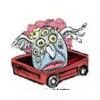Choosing the Right Equipment for Your Warehouse Needs
Published in Business Articles
Choosing the right equipment for your warehouse is not just about buying things. It’s about making work easier, safer, and more productive.
The right tools and machines help everything run smoothly and reduce accidents. It’ll also keep the workplace organized.
But with so many choices, how do you know what’s best? Learning what to look for will help you make smart decisions and keep your warehouse working at its best!
Understanding Your Warehouse Needs
Before choosing the right equipment for your warehouse, it’s important to understand what your space needs. Start by looking at the types of products you store and how they should be kept.
Some items may need special shelving, while others might require climate control. Think about the size and weight of the items, how quickly orders need to be processed, and how easy it is to move around the warehouse.
Also, make sure to follow safety rules that apply to your industry to protect workers and prevent accidents. By carefully considering these details, you can choose the best equipment that helps your warehouse run smoothly, efficiently, and safely.
Equipment Types to Consider
Different warehouses have different requirements. This leads to a variety of equipment types that can be considered. Here are some essential categories you may want to explore:
Forklifts
Essential for lifting heavy goods, forklifts are a staple in any warehouse. Choosing the right forklift is based on load capacity and facility specifications. Forklift hire is often a flexible option for meeting short-term needs without long-term commitment.
Pallet Jacks
Useful for moving items over short distances, pallet jacks come in manual and electric versions. They require less space than forklifts and are economical.
Conveyor Systems
These systems help move products smoothly inside the warehouse. They work well in places with lots of items and can be designed to fit different spaces.
Having the right system makes it easier to transport goods quickly and efficiently. This keeps everything organized and running smoothly.
For businesses hesitant to invest in purchasing new vehicles, forklift hire services provide a practical solution to meet temporary needs without the investment burden.
Customization and Scalability
Every warehouse is different, and ready-made equipment might not always be the best fit. It’s important to choose tools and machines that can be adjusted to match how your warehouse works.
Also, think about the future! If your business is growing, make sure the equipment you pick can handle more work over time.
Storage Solutions
Optimizing storage is essential. Depending on your products, you may consider:
- shelving units
- pallet racking systems
- automated storage solutions
These options can maximize your warehouse space and facilitate better organization.
Safety Equipment
Safety should never be overlooked. Equip your warehouse with safety gear such as:
- helmets
- gloves
- high-visibility vests
Moreover, installing safety barriers and signages will guide employees successfully while adhering to regulations.
Assessing Costs and Budgeting
Choosing the right equipment also requires a thorough understanding of costs associated with each piece. Begin by establishing a budget that includes:
- Purchase price
- Operating costs (maintenance, fuel, etc.)
- Potential downtime costs
- Insurance and warranties
Understanding these expenses will help ensure you’re investing wisely in the right equipment tailored to your operations.
Safety First: Compliance and Training
Talking about warehouse equipment isn’t complete without focusing on safety. Following safety rules is very important to keep everyone protected at work.
Make sure all workers are trained on how to use equipment safely. Checking for safety risks regularly and updating safety rules helps keep everyone aware and ensures a safe workplace for all.
Evaluating Supplier Credibility
Once you have identified possible equipment, partner with credible suppliers. Conducting thorough research into potential suppliers can save you from future headaches. Look for providers with:
- A solid reputation
- Positive customer reviews
- Strong support and warranties
By working with credible suppliers, you can secure reliable equipment that stands the test of time.
Training Your Workforce
The best equipment only works well if your team knows how to use it properly. Spend time and effort on training programs to teach them the right way to use each tool.
This helps keep everyone safe and makes the equipment last longer. Also, it’ll help the whole team work better and faster.
Maintaining Equipment
Once you have your equipment, it’s important to take good care of it with regular maintenance. Checking it often helps it last longer and prevents expensive repairs.
Look for signs of damage, like cracks, rust, or loose parts, and fix them right away before they become bigger problems. Always follow the care instructions from the manufacturer, such as oiling moving parts or replacing worn-out pieces.
Taking care of your equipment keeps your warehouse running smoothly and makes it a safer place for everyone to work.
Utilizing Technology and Innovations
In an ever-evolving industry, technology can significantly enhance your warehouse operations. These can streamline processes:
- automated systems
- real-time tracking
- inventory management software
Ultimately, the right equipment integrated with technology can yield significant productivity gains.
Sustainability Considerations
As people focus more on protecting the environment, it’s important to make sure your warehouse follows eco-friendly practices. Try using energy-saving equipment to use less power and find safe ways to get rid of old machines.
Making smart choices for the environment not only helps the planet but can also save money and make your business look good to customers.
Some options include:
- Electric Forklifts
- Solar-Powered Equipment
Incorporating these environmentally friendly options promotes corporate social responsibility while optimizing warehouse operations.
Final Checks Before Purchase
Before buying or renting equipment for your warehouse, it’s important to take a final look at all the details to make the best decision.
First, carefully check your warehouse layout and how products move through the space. This is to ensure the equipment will fit and function properly. Compare different equipment options to find one that offers the best value while staying within your budget.
Additionally, make sure the equipment meets all safety rules and industry regulations to protect workers and avoid potential issues. Taking the time to double-check these factors will help you make a smart choice and improve efficiency. This will also keep your warehouse running smoothly for the long term.
Your Path to Optimal Equipment Selection
Choosing the right equipment is important for keeping your warehouse running smoothly. By knowing what your warehouse needs, comparing different equipment choices, and making sure workers are well-trained, you can create a safe and efficient workspace. The right equipment helps everyone work faster and better.
Start now by picking the best tools to improve your warehouse and make it more successful!
For more equipment tips, check out our blog posts.











Comments